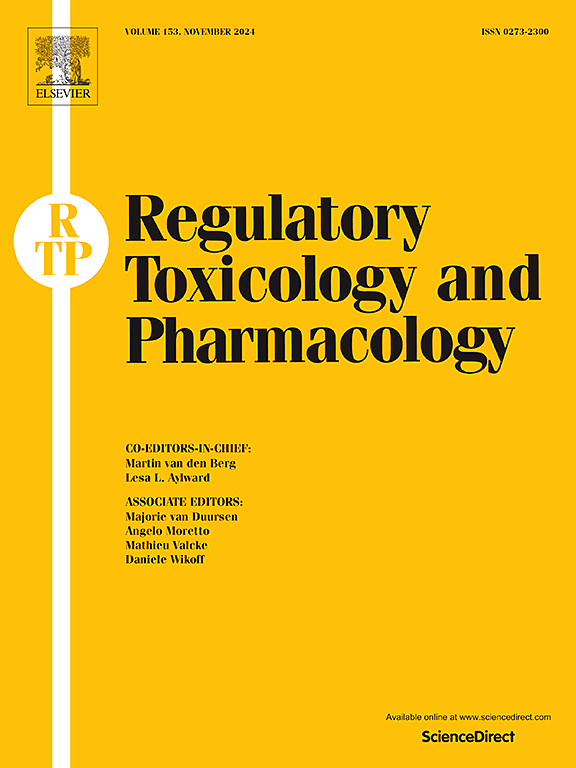虚拟对照组在非啮齿动物毒性研究中的统计应用:初步评估。
IF 3
4区 医学
Q1 MEDICINE, LEGAL
引用次数: 0
摘要
利用历史对照动物的数据组成虚拟对照组(VCGs)是一种创新方法,可在研究中体现 3R(减少、完善和替代对照动物的使用)原则。然而,在非啮齿动物安全性评估中,目前还没有系统地比较同期对照组(CCGs)和虚拟对照组的统计性能。VCGs和CCGs的最佳选择标准和组合也仍不明确。本研究回顾性地评估了VCGs在狗和非人灵长类动物(NHP)全身毒性研究中检测试验品对体重和临床病理学终点影响的统计性能。使用三种不同的 VCG 生成方法,对照先前报告的 22 项非啮齿类动物 1 个月口服灌胃毒性的研究结果,对体重和六项临床病理终点进行了分析。当使用与基线相比的折叠变化时,VCGs 在检测测试物相关性方面的统计灵敏度与 CCGs 相似或更高。与简单随机抽样或使用固定标准相比,按体重、年龄和研究开始年份进行倾向评分匹配的灵敏度更高。我们的分析支持这样的假设,即在非啮齿动物毒性研究中,VCGs 是一种可行的工具。本文章由计算机程序翻译,如有差异,请以英文原文为准。
Statistical applications of virtual control groups to nonrodent animal toxicity studies: An initial evaluation
Utilization of data from historical control animals to form virtual control groups (VCGs) is an innovative approach to embody the 3Rs (reduce, refine, and replace use of control animals) principle in research. However, there is no available systematic comparison of statistical performance between concurrent control groups (CCGs) and VCGs in nonrodent safety assessment. The optimal selection criteria and combination of VCGs and CCGs also remain unclear. This study retrospectively evaluated VCGs’ statistical performance to detect test article effects on body weight and clinical pathology endpoints in dog and nonhuman primate (NHP) systemic toxicity studies. Body weight and six clinical pathology endpoints were analyzed against the reported study findings from a cohort of 22 previously reported nonrodent 1-month oral gavage toxicity using three different methods of generating VCGs. When the fold change from baseline was used, VCGs yielded a similar or higher statistical sensitivity to detect test article relatedness than CCGs. Compared to simple random sampling or using fixed criteria, the propensity score matching by BW, age, and year of study initiation yielded higher sensitivities. Our analysis supports the hypothesis that VCGs can be a viable instrument in nonrodent toxicity studies.
求助全文
通过发布文献求助,成功后即可免费获取论文全文。
去求助
来源期刊
CiteScore
6.70
自引率
8.80%
发文量
147
审稿时长
58 days
期刊介绍:
Regulatory Toxicology and Pharmacology publishes peer reviewed articles that involve the generation, evaluation, and interpretation of experimental animal and human data that are of direct importance and relevance for regulatory authorities with respect to toxicological and pharmacological regulations in society. All peer-reviewed articles that are published should be devoted to improve the protection of human health and environment. Reviews and discussions are welcomed that address legal and/or regulatory decisions with respect to risk assessment and management of toxicological and pharmacological compounds on a scientific basis. It addresses an international readership of scientists, risk assessors and managers, and other professionals active in the field of human and environmental health.
Types of peer-reviewed articles published:
-Original research articles of relevance for regulatory aspects covering aspects including, but not limited to:
1.Factors influencing human sensitivity
2.Exposure science related to risk assessment
3.Alternative toxicological test methods
4.Frameworks for evaluation and integration of data in regulatory evaluations
5.Harmonization across regulatory agencies
6.Read-across methods and evaluations
-Contemporary Reviews on policy related Research issues
-Letters to the Editor
-Guest Editorials (by Invitation)

 求助内容:
求助内容: 应助结果提醒方式:
应助结果提醒方式:


